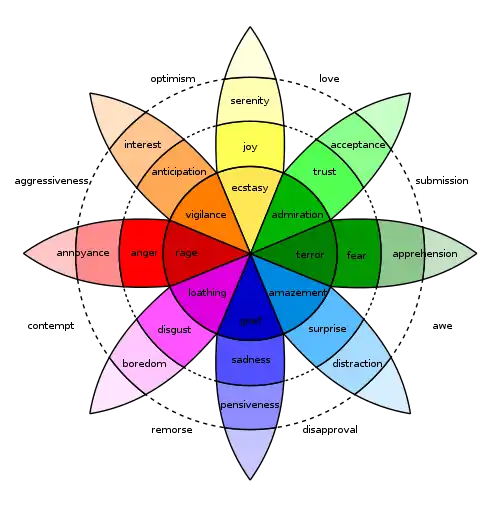Sadness
Sadness is an emotional pain associated with, or characterized by, feelings of disadvantage, loss, despair, grief, helplessness, disappointment and sorrow. An individual experiencing sadness may become quiet or lethargic, and withdraw themselves from others. An example of severe sadness is depression, a mood which can be brought on by major depressive disorder or persistent depressive disorder. Crying can be an indication of sadness.[1]

Sadness is one of the "six basic emotions" described by Paul Ekman, along with happiness, anger, surprise, fear, and disgust.[2]:271–4
Childhood
_-_BEIC_6363533.jpg.webp)
Sadness is a common experience in childhood. Sometimes, sadness can lead to depression. Some families may have a (conscious or unconscious) rule that sadness is "not allowed",[3] but Robin Skynner has suggested that this may cause problems, arguing that with sadness "screened off", people can become shallow and manic.[4]:33; 36 Pediatrician T. Berry Brazelton suggests that acknowledging sadness can make it easier for families to address more serious emotional problems.[5]:46; 48
Sadness is part of the normal process of the child separating from an early symbiosis with the mother and becoming more independent. Every time a child separates a little more, he or she will have to cope with a small loss. If the mother cannot allow the minor distress involved, the child may never learn how to deal with sadness by themselves.[4]:158–9 Brazelton argues that too much cheering a child up devalues the emotion of sadness for them;[5]:52 and Selma Fraiberg suggests that it is important to respect a child's right to experience a loss fully and deeply.[6]
Margaret Mahler also saw the ability to feel sadness as an emotional achievement, as opposed for example to warding it off through restless hyperactivity.[7] D. W. Winnicott similarly saw in sad crying the psychological root of valuable musical experiences in later life.[8]
Neuroanatomy
A large amount of research has been conducted on the neuroscience of sadness.[9] According to the American Journal of Psychiatry, sadness has been found to be associated with "increases in bilateral activity within the vicinity of the middle and posterior temporal cortex, lateral cerebellum, cerebellar vermis, midbrain, putamen, and caudate."[10] Jose V. Pardo has his M.D and Ph.D and leads a research program in cognitive neuroscience. Using positron emission tomography (PET) Pardo and his colleagues were able to provoke sadness among seven normal men and women by asking them to think about sad things. They observed increased brain activity in the bilateral inferior and orbitofrontal cortex.[11] In a study that induced sadness in subjects by showing emotional film clips, the feeling was correlated with significant increases in regional brain activity, especially in the prefrontal cortex, in the region called Brodmann's area 9, and the thalamus. A significant increase in activity was also observed in the bilateral anterior temporal structures.[12]
Coping mechanisms


People deal with sadness in different ways, and it is an important emotion because it helps to motivate people to deal with their situation. Some coping mechanisms include: getting social support and/or spending time with a pet,[13] creating a list, or engaging in some activity to express sadness.[14] Some individuals, when feeling sad, may exclude themselves from a social setting, so as to take the time to recover from the feeling.
While being one of the moods people most want to shake, sadness can sometimes be perpetuated by the very coping strategies chosen, such as ruminating, "drowning one's sorrows", or permanently isolating oneself.[2]:69–70 As alternative ways of coping with sadness to the above, cognitive behavioral therapy suggests instead either challenging one's negative thoughts, or scheduling some positive event as a distraction.[2]:72
Being attentive to, and patient with, one's sadness may also be a way for people to learn through solitude;[15] while emotional support to help people stay with their sadness can be further helpful.[4]:164 Such an approach is fueled by the underlying belief that loss (when felt wholeheartedly) can lead to a new sense of aliveness, and to a re-engagement with the outside world.[16]
Pupil empathy
Pupil size may be an indicator of sadness. A sad facial expression with small pupils is judged to be more intensely sad as the pupil size decreases.[17] A person's own pupil size also mirrors this and becomes smaller when viewing sad faces with small pupils. No parallel effect exists when people look at neutral, happy or angry expressions.[17] The greater degree to which a person's pupils mirror another predicts a person's greater score on empathy.[18] However, in disorders such as autism and psychopathy facial expressions that represent sadness may be subtle, which may show a need for a more non-linguistic situation to affect their level of empathy.[18]
Vocal expression
According to DIPR scientist Swati Johar,[19]:VII sadness is an emotion "identified by current speech dialogue and processing systems".[19]:12 Measurements to distinguish sadness from other emotions in the human voice include root mean square (RMS) energy, inter-word silence and speaking rate.[20] It is communicated mostly by lowering the mean and variability of the fundamental frequency (f0), besides being associated with lower vocal intensity, and with decreases in f0 over time.[21][22] Johar argues that, "when someone is sad, slow, low pitched speech with weak high audio frequency energy is produced". Likewise, "low energy state of sadness attributes to slow tempo, lower speech rate and mean pitch".[19]:10; 13
Sadness is, as stated by Klaus Scherer, one of the "best-recognized emotions in the human voice", although it's "generally somewhat lower than that of facial expression". In a study by Scherer, it was found that in Western countries sadness had 79% of accuracy for facial recognition and 71% for vocal, while in Non-Western countries the results were of 74% and 58%, respectively.[23]
Cultural explorations

During the Renaissance, Edmund Spenser in The Faerie Queene endorsed sadness as a marker of spiritual commitment.[24]
In The Lord of the Rings, sadness is distinguished from unhappiness,[25] to exemplify J. R. R. Tolkien's preference for a sad, but settled determination, as opposed to what he saw as the shallower temptations of either despair or hope.[26]
Julia Kristeva considered that "a diversification of moods, variety in sadness, refinement in sorrow or mourning are the imprint of a humanity that is surely not triumphant but subtle, ready to fight and creative".[27]
See also
References
- Jellesma, F.C.; Vingerhoets, Ad J.J.M. (1 January 2012). "Crying in Middle Childhood: A Report on Gender Differences". Sex Roles. 67 (7): 412–21. doi:10.1007/s11199-012-0136-4. PMC 3432210. PMID 22962516.
- Goleman, Daniel (1996). Emotional Intelligence. London, United Kingdom. Archived from the original on 2018-06-21. Retrieved 2018-06-21.
- Masman, Karen (21 July 2010). The Uses of Sadness: Why Feeling Sad is No Reason Not to be Happy. Allen & Unwin. p. 8. ISBN 9781741757576.
- Skynner, Robin; Cleese, John (1994). Families and How to Survive Them.
- Brazelton, T. Berry (1992). To Listen to a Child.
- Fraiberg, Selma H. (1987). The Magic Years. New York, United States. p. 274.
- Mahler, Margaret S.; Pine, Fred; Bergman, Annl (1975). The Psychological Birth of the Human Infant: Symbiosis and Individuation. London, United Kingdom. p. 92.
- Winnicott, D.W. (1973). The Child, the Family, and the Outside World. United Kingdom: Penguin Books. p. 64.
- Arias, Juan A.; Williams, Claire; Raghvani, Rashmi; Aghajani, Moji; Baez, Sandra; Belzung, Catherine; Booij, Linda; Busatto, Geraldo; Chiarella, Julian; Fu, Cynthia HY; Ibanez, Agustin; Liddell, Belinda J.; Lowe, Leroy; Penninx, Brenda W.J.H.; Rosa, Pedro; Kemp, Andrew H. (April 2020). "The neuroscience of sadness: A multidisciplinary synthesis and collaborative review". Neuroscience & Biobehavioral Reviews. 111: 199–228. doi:10.1016/j.neubiorev.2020.01.006. PMID 32001274.
- Lane, R.D.; Reiman, E.M.; Ahern, G.L.; Schwartz, G.E.; Davidson, R.J. (July 1997). "Neuroanatomical Correlates of Happiness, Sadness, and Disgust". American Journal of Psychiatry. 154 (7): 926–33. doi:10.1176/ajp.154.7.926. PMID 9210742.
- Pardo, J.V.; Pardo, P.J.; Raichle, M.E. (May 1993). "Neural correlates of self-induced dysphoria". American Journal of Psychiatry. 150 (5): 713–9. doi:10.1176/ajp.150.5.713. PMID 8480815.
- George, M.S.; Ketter, T.A.; Parekh, J.I.; Horwitz, B.; Herscovitch, P.; Post, R.M. (March 1995). "Brain activity during transient sadness and happiness in healthy women". American Journal of Psychiatry. 152 (3): 341–51. CiteSeerX 10.1.1.468.2440. doi:10.1176/ajp.152.3.341. PMID 7864258.
- Bos, E.H.; Snippe, E.; de Jonge, P.; Jeronimus, B.F. (2016). "Preserving Subjective Wellbeing in the Face of Psychopathology: Buffering Effects of Personal Strengths and Resources". PLOS ONE. 11 (3): e0150867. doi:10.1371/journal.pone.0150867. PMC 4786317. PMID 26963923.
- "Why It's Import to Express Your Sadness". Free Online Therapy. October 2018. Archived from the original on 2018-11-29.
- Barnstone, Aliki (2000). "New England Review (1990–)". Spring. 21 (2): 19. ISSN 1053-1297. JSTOR i40009359.
- Parsons, Michael (13 August 2000). The Dove that Returns, the Dove that Vanishes: Paradox and Creativity in Psychoanalysis. London, United Kingdom: Routledge. p. 4. ISBN 978-0415211826.
- Harrison, Neil A.; Singer, Tania; Rotshtein, Pia; Dolan, Ray J.; Critchley, Hugo D. (1 June 2006). "Pupillary contagion: central mechanisms engaged in sadness processing". Social Cognitive and Affective Neuroscience. 1 (1): 5–17. doi:10.1093/scan/nsl006. PMC 1716019. PMID 17186063.
- Harrison, Neil A.; Wilson, C.E.; Critchley, H.D. (November 2007). "Processing of observed pupil size modulates perception of sadness and predicts empathy". Emotion. 7 (4): 724–9. doi:10.1037/1528-3542.7.4.724. PMID 18039039.
- Johar, Swati (22 December 2015). Emotion, Affect and Personality in Speech: The Bias of Language and Paralanguage. SpringerBriefs in Speech Technology. Springer. ISBN 978-3-319-28047-9. Archived from the original on 21 June 2018. Retrieved 21 June 2018.
- Yildirim, Serdar; Bulut, Murtaza; M. Lee, Chul; Kazemzadeh, Abe; Busso, Carlos; Deng, Zhigang; Lee, Sungbok; Narayanan, Shrikanth (2004). "An acoustic study of emotions expressed in speech" (PDF). ISCA: 1. Retrieved 20 June 2018.
- Stolarski, Łukasz (2015). "Pitch Patterns in Vocal Expression of "Happiness" and "Sadness" in the Reading Aloud of Prose on the Basis of Selected Audiobooks" (PDF). Research in Language. 13 (2): 141–162. doi:10.1515/rela-2015-0016. S2CID 52998542. Retrieved 20 June 2018.
- Bachorowski, Jo-Anne (20 April 1999). "Vocal Expression and Perception of Emotion" (PDF). Current Directions in Psychological Science. 8 (2): 53–57. doi:10.1111/1467-8721.00013. S2CID 18785659. Archived (PDF) from the original on 30 August 2017. Retrieved 21 June 2018.
- Scherer, Klaus R. (2003). "Vocal communication of emotion: A review of research paradigms". Speech Communication. 40 (1–2): 235–6. doi:10.1016/S0167-6393(02)00084-5.
- Trevor, Douglas (30 September 2004). The Poetics of Melancholy in Early Modern England. Cambridge Studies in Renaissance Literature and Culture. United Kingdom: Cambridge University Press. p. 48. ISBN 9780521834698.
- Tolkien, J.R.R. (1991). The Lord of the Rings. London, United Kingdom: HarperCollins. p. 475. ISBN 9780261102309.
- Sippey, Tom A. (1992). The Road to Middle-Earth: How J.R.R. Tolkien Created a New Mythology. London, United Kingdom: HarperCollins. p. 143. ISBN 9780261102750.
- Phillips, Adam (1994). On Flirtation. London, United Kingdom: Harvard University Press. p. 87. ISBN 9780674634404. Archived from the original on 2018-06-21. Retrieved 2018-06-21.
Further reading
- Karp DA (1997). Speaking of Sadness. ISBN 978-0195113860.
- Keltner D; Ellsworth PC; Edwards K (May 1993). "Beyond simple pessimism: effects of sadness and anger on social perception". J Pers Soc Psychol. 64 (5): 740–52. doi:10.1037/0022-3514.64.5.740. PMID 8505705.
- Tiedens LZ (January 2001). "Anger and advancement versus sadness and subjugation: the effect of negative emotion expressions on social status conferral". J Pers Soc Psychol. 80 (1): 86–94. doi:10.1037/0022-3514.80.1.86. PMID 11195894.
- Ambady & Gray, 2002
- Forgas JP (March 1998). "On feeling good and getting your way: mood effects on negotiator cognition and bargaining strategies". J Pers Soc Psychol. 74 (3): 565–77. doi:10.1037/0022-3514.74.3.565. PMID 11407408.
- Forgas JP (August 1998). "On being happy and mistaken: mood effects on the fundamental attribution error". J Pers Soc Psychol. 75 (2): 318–31. doi:10.1037/0022-3514.75.2.318. PMID 9731311.
- Forgas JP (1994). "The role of emotion in social judgments: an introductory review and an Affect Infusion Model (AIM)". Eur J Soc Psychol. 24 (1): 1–24. doi:10.1002/ejsp.2420240102.
- Forgas JP; Bower GH (July 1987). "Mood effects on person-perception judgments". J Pers Soc Psychol. 53 (1): 53–60. doi:10.1037/0022-3514.53.1.53. PMID 3612493.
- Isen AM; Daubman KA; Nowicki GP (June 1987). "Positive affect facilitates creative problem solving". J Pers Soc Psychol. 52 (6): 1122–31. doi:10.1037/0022-3514.52.6.1122. PMID 3598858.
- Keltner D; Kring AM (1998). "Emotion, social function, and psychopathology" (PDF). Review of General Psychology. 2 (3): 320–342. CiteSeerX 10.1.1.315.1265. doi:10.1037/1089-2680.2.3.320. S2CID 247805. Archived from the original (PDF) on 2007-06-11.

